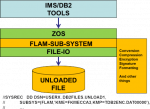Projects
In the following we present a few projects within which the FLAM infrastructure has been or might be deployed

For ordering of credit cards and other batch processes based on the cryptographic infrastructure for the Financial-PIN-Support we have created a solution that implements both storage and transfer of data in compliance with PCIDSS.

The network-capability of FLAM allows storing encrypted archives securely in a cloud. Since compression requires cumulating a certain amount of data anyway, latency times caused by DSL when transferring many small packets pose no longer a problem.

With FLAM you can search in compressed and encrypted data without making them legible. This is used primarily in large archives that cannot be kept online in a database and which are securely outsourced to a third-party operator.

Wer die EDITPROC zur Verschlüsselung der Tablespaces in DB2 benutzt, würde gerne mit dem gleichen Schlüssel If you use EDITPROC for encrypting of the tablespaces in DB2 you would prefer to protect offline data at unload with the same key. With FLAM subsystem and our FKME-ICSF on the host this can be easily implemented.





